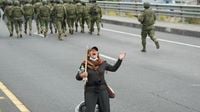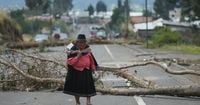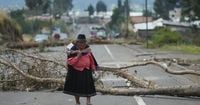For nearly three weeks, Ecuador has been gripped by a wave of protests that show no sign of slowing down, plunging President Daniel Noboa’s administration into its most fraught crisis yet. The unrest, sparked by a government decision to end diesel fuel subsidies, has brought together striking bus drivers, angry farmers, and the country’s most powerful Indigenous organization, CONAIE, in a standoff that’s left the nation’s streets blocked and its politics on edge.
The trouble began on September 12, 2025, when Noboa’s government announced it was eliminating a longstanding subsidy on diesel fuel. According to reporting from AP, the move instantly raised the price of a gallon of diesel from $1.80 to $2.80—a staggering increase for a country where diesel powers not just buses and trucks, but also the livelihoods of countless farmers and fishers, many of whom are Indigenous. The backlash was immediate and fierce. Bus drivers walked off the job, farmers set up roadblocks, and CONAIE—the Confederation of Indigenous Nationalities of Ecuador—called for nationwide protests and a general strike.
As the demonstrations stretched into their 18th day by October 9, tensions only mounted. The government’s response was swift and forceful: over 5,000 troops were deployed to the capital, Quito, after earlier marches in the city, with the army announcing its intent to prevent vandalism and destruction of property. The protests, while meant to be nationwide, have hit the northern province of Imbabura particularly hard—a region where Noboa secured 52 percent of the vote in April’s presidential election, according to Al Jazeera.
The situation has not unfolded without tragedy. Last week, a protester was killed amid clashes, and video footage surfaced of soldiers attacking a man who tried to help the fallen demonstrator. The images, widely circulated, have stoked public anger and drawn criticism from both domestic and international organizations over the government’s use of force. The Attorney General’s Office has since launched an investigation into the protester’s death. With more than 100 people arrested and numerous injuries on both sides, the human cost of the standoff is mounting.
President Noboa, just 37 years old and the scion of a wealthy banana dynasty, has shown little inclination to back down or open the door to dialogue. Since beginning his second term in May, he’s governed with a heavy hand—raising the value-added tax from 12 to 15 percent, firing thousands of government workers, and restructuring the executive branch. His rationale? The country needs more revenue to combat crime and stabilize the economy. But for many Ecuadorians, especially those in the lower and middle classes, these policies have only deepened hardship.
“The law awaits those who choose violence. Those who act like criminals will be treated like criminals,” Noboa declared, as quoted by Al Jazeera. His administration has consistently framed the protests as a threat to public order, especially after demonstrators attacked his motorcade with rocks on October 7—a move the government denounced as an assassination attempt. CONAIE, for its part, rejected the accusation, insisting its demonstrations are peaceful and that it’s the government that has escalated the situation with force.
The roots of the crisis run deep. Diesel is a lifeline for Ecuador’s agricultural and transport sectors. The subsidy’s removal, CONAIE argues, hits the poor the hardest. The government tried to placate the opposition by offering handouts, but unions stayed on the sidelines, and CONAIE dismissed the offers as insufficient, doubling down on its call for a general strike. “We are fighting for a decent life for all Ecuadorians,” the confederation has stated, framing its demands as a matter of basic rights rather than political maneuvering.
Observers say the current unrest is the latest chapter in a long history of Indigenous-led protest in Ecuador. CONAIE has played a pivotal role in past uprisings, including those in 2019 and 2022 that nearly toppled then-presidents Lenin Moreno and Guillermo Lasso. Yet, as Daniel Crespo, an international relations professor at the Universidad de los Hemisferios in Quito, told Al Jazeera, the confederation’s hardline tactics can sometimes backfire. “Their demands to return the fuel subsidy, cut a tax and stop mining are efforts to impose their political agenda,” he said, suggesting that the group’s uncompromising stance has made negotiations difficult.
Farith Simon, a law professor at the Universidad San Francisco in Quito, sees a broader struggle at play. “On one side is a president who assumes that after winning the elections he has all of the power at his disposal, who has authoritarian tendencies and no disposition for dialogue,” Simon explained. “On the other side is an Indigenous sector that has shown itself to be uncompromising and is looking to co-govern through force.”
The standoff has left Ecuadorians anxious about what comes next. Experts warn that if protests spread from rural areas to major cities like Quito, the situation could escalate rapidly, with frustrated civilians potentially taking to the streets to confront demonstrators. “Some party needs to intervene and lead the different sides to dialogue, perhaps the Catholic Church or civil society organisations,” Crespo and Simon agreed in their comments to Al Jazeera.
For now, both sides remain entrenched. The government, under pressure to shore up state finances and maintain order, appears unwilling to reverse course or engage in meaningful talks. Protesters, meanwhile, are determined to keep up the pressure until their demands are met, even as the risks mount. The death of a protester, the deployment of thousands of troops, and the specter of further violence have underscored just how high the stakes have become.
As Ecuador stands at this crossroads, the choices made in the coming days will likely shape the nation’s political landscape for years to come. For President Noboa, the crisis is a defining test of leadership. For CONAIE and its supporters, it’s a fight not just over fuel prices, but for the future of Ecuador’s democracy and social contract. The world is watching—hoping that, somehow, dialogue and compromise will prevail over confrontation and force.



